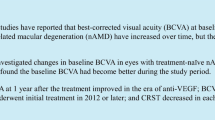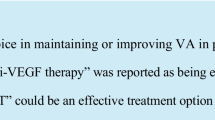Abstract
Purpose
In this study (AMD2000), we aimed to determine the visual prognosis of Japanese patients with age-related macular degeneration (AMD).
Methods
This was a multicenter prospective observational cohort study. In total, 460 patients with AMD were recruited from April 2006 to March 2009 from 18 clinical trial sites in Japan. They were followed up for 5 years, as they continued to receive medical treatment.
Results
Of the 409 study eyes followed up for at least 1 year, 243 eyes (59.4%) were treated with photodynamic therapy (PDT) using verteporfin, and 58 eyes (14.2%) were treated with intravitreal injections of antivascular endothelial growth factor agents as the initial treatment. The mean best-corrected visual acuities (BCVA) for typical AMD (tAMD; 0.688 ± 0.498) and polypoidal choroidal vasculopathy (PCV; 0.451 ± 0.395) were significantly less at 2 years (tAMD, 0.779 ± 0.632, P < 0.05; PCV, 0.534 ± 0.618, P < 0.05) and at 5 years (AMD, 0.873 ± 0.718, P < 0.05; PCV, 0.635 ± 0.668, P < 0.05) than at baseline. In eyes with tAMD, absence of blocked fluorescence was associated with 5-year maintenance of the baseline BCVA. Regarding PCV, the presence of polypoidal lesions and cystoid macular edema as well as the lesion size was associated with 5-year maintenance of the baseline BCVA. In some patients, the diagnosis changed: of the 192 eyes initially diagnosed with typical AMD, 19 were newly diagnosed with PCV during follow-up.
Conclusion
Maintaining the baseline BCVA over the long term is difficult in Japanese eyes with wet AMD.


Similar content being viewed by others
References
Wong WL, Su X, Li X, Cheung CM, Klein R, Cheng CY, et al. Global prevalence of age-related macular degeneration and disease burden projection for 2020 and 2040: a systematic review and meta-analysis. Lancet Glob Health. 2014;2:e106–16.
Danis RP, Lavine JA, Domalpally A. Geographic atrophy in patients with advanced dry age-related macular degeneration: current challenges and future prospects. Clin Ophthalmol. 2015;9:2159–74.
Wong CW, Yanagi Y, Lee WK, Ogura Y, Yeo I, Wong TY, et al. Age-related macular degeneration and polypoidal choroidal vasculopathy in Asians. Prog Retin Eye Res. 2016;53:107–39.
Oishi A, Tsujikawa A, Yamashiro K, Ooto S, Tamura H, Nakanishi H, et al. One-year result of aflibercept treatment on age-related macular degeneration and predictive factors for visual outcome. Am J Ophthalmol. 2015;159(853–60):e1.
Saito M, Kano M, Itagaki K, Sekiryu T. Efficacy of intravitreal aflibercept in Japanese patients with exudative age-related macular degeneration. Jpn J Ophthalmol. 2017;61:74–83.
Hosokawa M, Morizane Y, Hirano M, Kimura S, Kumase F, Shiode Y, et al. One-year outcomes of a treat-and-extend regimen of intravitreal aflibercept for polypoidal choroidal vasculopathy. Jpn J Ophthalmol. 2017;61:150–8.
Bird AC, Bressler NM, Bressler SB, Chisholm IH, Coscas G, Davis MD, et al. An international classification and grading system for age-related maculopathy and age-related macular degeneration: the International ARM Epidemiological Study Group. Surv Ophthalmol. 1995;39:367–74.
Zhang J, Yu Z, Liu L. Multimodality imaging in diagnosing polypoidal choroidal vasculopathy. Optom Vis Sci. 2015;92:e21–6.
Semoun O, Coscas F, Coscas G, Lalloum F, Srour M, Souied EH. En face enhanced depth imaging optical coherence tomography of polypoidal choroidal vasculopathy. Br J Ophthalmol. 2016;100:1028–34.
Yannuzzi LA, Sorenson J, Spaide RF, Lipson B. Idiopathic polypoidal choroidal vasculopathy (IPCV). Retina. 1990;10:1–8.
Iijima H, Imai M, Gohdo T, Tsukahara S. Optical coherence tomography of idiopathic polypoidal choroidal vasculopathy. Am J Ophthalmol. 1999;127:301–5.
Sato T, Kishi S, Watanabe G, Matsumoto H, Mukai R. Tomographic features of branching vascular networks in polypoidal choroidal vasculopathy. Retina. 2007;27:589–94.
Japanese age-related macular degeneration trial. 1-year results of photodynamic therapy with verteporfin in Japanese patients with subfoveal choroidal neovascularization secondary to age-related macular degeneration. Am J Ophthalmol. 2003;136:1049–61.
Tano Y. Pegaptanib Sodium Multi-center Study, G. Pegaptanib sodium one-year treatment study for neovascular age-related macular degeneration [in Japanese]. Nippon Ganka Gakkai Zasshi. 2008;112:590–600.
Japanese Study Group of Polypoidal Choroidal Vasculopathy. Criteria for diagnosis of polypoidal choroidal vasculopathy [in Japanese]. Nippon Ganka Gakkai Zasshi. 2005;109:417–27.
Yannuzzi LA, Negrao S, Iida T, Carvalho C, Rodriguez-Coleman H, Slakter J, et al. Retinal angiomatous proliferation in age-related macular degeneration. Retina. 2001;21:416–34.
Hirami Y, Mandai M, Takahashi M, Teramukai S, Tada H, Yoshimura N. Association of clinical characteristics with disease subtypes, initial visual acuity, and visual prognosis in neovascular age-related macular degeneration. Jpn J Ophthalmol. 2009;53:396–407.
Treatment of age-related macular degeneration with photodynamic therapy (TAP) Study Group. Photodynamic therapy of subfoveal choroidal neovascularization in age-related macular degeneration with verteporfin: one-year results of 2 randomized clinical trials—TAP report. Arch Ophthalmol. 1999;117:1329–45.
Group VISiONCT, Chakravarthy U, Adamis AP, Cunningham ET Jr, Goldbaum M, Guyer DR, et al. Year 2 efficacy results of 2 randomized controlled clinical trials of pegaptanib for neovascular age-related macular degeneration. Ophthalmology. 2006;113:1508(e1–25).
Newman DK. Photodynamic therapy: current role in the treatment of chorioretinal conditions. Eye (Lond). 2016;30:202–10.
Gomi F, Ohji M, Sayanagi K, Sawa M, Sakaguchi H, Oshima Y, et al. One-year outcomes of photodynamic therapy in age-related macular degeneration and polypoidal choroidal vasculopathy in Japanese patients. Ophthalmology. 2008;115:141–6.
Otani A, Sasahara M, Yodoi Y, Aikawa H, Tamura H, Tsujikawa A, et al. Indocyanine green angiography: guided photodynamic therapy for polypoidal choroidal vasculopathy. Am J Ophthalmol. 2007;144:7–14.
Koh A, Lee WK, Chen LJ, Chen SJ, Hashad Y, Kim H, et al. EVEREST study: efficacy and safety of verteporfin photodynamic therapy in combination with ranibizumab or alone versus ranibizumab monotherapy in patients with symptomatic macular polypoidal choroidal vasculopathy. Retina. 2012;32:1453–64.
Koh A, Lai TYY, Takahashi K, Wong TY, Chen LJ, Ruamviboonsuk P, et al. Efficacy and safety of ranibizumab with or without verteporfin photodynamic therapy for polypoidal choroidal vasculopathy: a randomized clinical trial. JAMA Ophthalmol. 2017;135:1206–13.
Kikushima W, Sakurada Y, Sugiyama A, Tanabe N, Yoneyama S, Iijima H. Retreatment of polypoidal choroidal vasculopathy after photodynamic therapy combined with intravitreal ranibizumab. Jpn J Ophthalmol. 2017;61:61–6.
Singer MA, Awh CC, Sadda S, Freeman WR, Antoszyk AN, Wong P, et al. HORIZON: an open-label extension trial of ranibizumab for choroidal neovascularization secondary to age-related macular degeneration. Ophthalmology. 2012;119:1175–83.
Rofagha S, Bhisitkul RB, Boyer DS, Sadda SR, Zhang K, SEVEN-UP Study Group. Seven-year outcomes in ranibizumab-treated patients in ANCHOR, MARINA, and HORIZON: a multicenter cohort study (SEVEN-UP). Ophthalmology. 2013;120:2292–9.
Kurashige Y, Otani A, Sasahara M, Yodoi Y, Tamura H, Tsujikawa A, et al. Two-year results of photodynamic therapy for polypoidal choroidal vasculopathy. Am J Ophthalmol. 2008;146:513–9.
Akaza E, Mori R, Yuzawa M. Long-term results of photodynamic therapy of polypoidal choroidal vasculopathy. Retina. 2008;28:717–22.
Tsujikawa A, Ojima Y, Yamashiro K, Nakata I, Ooto S, Tamura H, et al. Association of lesion size and visual prognosis to polypoidal choroidal vasculopathy. Am J Ophthalmol. 2011;151(961–72):e1.
Tsujikawa A, Ojima Y, Yamashiro K, Ooto S, Tamura H, Nakata I, et al. Development of polypoidal lesions in age-related macular degeneration. Eye (Lond). 2011;25:481–8.
Imamura Y, Engelbert M, Iida T, Freund KB, Yannuzzi LA. Polypoidal choroidal vasculopathy: a review. Surv Ophthalmol. 2010;55:501–15.
Acknowledgements
We are grateful to all patients and coinvestigators for their cooperation for the current study. Principal investigator Nagahisa Yoshimura (Kyoto University Hospital). Co-principal investigator Tatsuro Ishibashi (Kyushu University Hospital) and Mitsuko Yuzawa (Surugadai Nihon University Hospital). Research sites and investigators Sapporo City General Hospital, Hokkaido (Muneyasu Takeda, Hiroko Imaizumi, Utako Okushiba); Hirosaki University Hospital, Aomori (Mitsuru Nakazawa, Yukihiko Suzuki); Yamagata University Hospital, Yamagata (Hidetoshi Yamashita, Daijiro Tsuchiya); Gunma University Hospital, Gunma (Shoji Kishi, Ryo Mukai, Maki Takahashi, Taku Sato, Hidetaka Matsumoto); Tokyo Medical University Ibaraki Medical Center, Ibaraki (Masahiro Miura); Surugadai Nihon University Hospital, Tokyo (Mitsuko Yuzawa, Ryuzaburo Mori); Tokyo University Hospital, Tokyo (Yasuhiro Tamaki, Ryo Obata, Yasuo Yanagi); Tokyo Medical University Hospital, Tokyo (Takuya Iwasaki, Yasuyuki Yamauchi); Yokohama City University Medical Center, Kanagawa (Kazuaki Kadonosono, Maiko Inoue, Misa Suzuki); Seirei Hamamatsu General Hospital, Shizuoka (Akira Obana); Fujita Health University Hospital, Aichi (Masayuki Horiguchi, Atsuhiro Tanikawa); Kyoto University Hospital, Kyoto (Nagahisa Yoshimura, Akitaka Tsujikawa, Hideo Nakanishi, Yumiko Akagi-Kurashige, Kenji Yamashiro, Atsushi Otani, Hiroshi Tamura, Ayako Takahashi, Akio Oishi); Osaka University Hospital, Osaka (Fumi Gomi, Miki Sawa); Osaka Medical College Hospital, Osaka (Tsunehiko Ikeda, Masahiro Minami); Kansai Medical University Hospital, Osaka (Kanji Takahashi); Kansai Medical University Takii Hospital, Osaka (Kenichiro Sho); Kobe University Hospital, Hyogo (Shigeru Honda); Kagoshima University Medical and Dental Hospital, Kagoshima (Taiji Sakamoto, Akiko Okubo). The authors also thank the following additional investigators of the Translational Research Informatics Center for their contributions to this trial: Emiko Uno for data management; Yasuko Kimura for project management; and Hideaki Kaneda, Mikio Yoshidomi, Shinsuke Kojima, and Atsuhiko Kawamoto for manuscript review.
Author information
Authors and Affiliations
Consortia
Corresponding author
Ethics declarations
Conflicts of interest
Y. Akagi-Kurashige, None; A. Tsujikawa, Grant (Alcon, AMO Japan, Bayer, HOYA, Kowa, Novartis, Pfizer, Santen, Senju), Lecture fees, (Alcon, AMO Japan, Bayer, Chugai, Kowa, Nidek, Novartis, Pfizer, Santen, Sanwa Kagaku, Senju); M. Yuzawa, Grant (Alcon Japan, Santen), Consultant fees (Alcon Japan, Astellas Pharma, Janssen Japan), Lecture fees (Astellas Pharma, Bausch & Lomb Japan, Bayer, Japan Focus Company, Novartis, Santen, Senju); T. Ishibashi, None; H. Nakanishi, None; E. Nakatani, None; S. Teramukai, Grant (Daiichi Sankyo), Consultant fee (Daiichi Sankyo, Sanofi, Solasia Pharma, Sysmex, Taiho Pharmaceutical), Lecture fees (Bristol-Myers Squibb, Fujifilm); M. Fukushima, None; N. Yoshimura, None.
Additional information
Members of AMD2000 study group are listed in the acknowledgements.
About this article
Cite this article
Akagi-Kurashige, Y., Tsujikawa, A., Yuzawa, M. et al. A 5-year multicenter prospective cohort study on the long-term visual prognosis and predictive factors for visual outcome in Japanese patients with age-related macular degeneration: the AMD2000 study. Jpn J Ophthalmol 62, 137–143 (2018). https://doi.org/10.1007/s10384-017-0554-5
Received:
Accepted:
Published:
Issue Date:
DOI: https://doi.org/10.1007/s10384-017-0554-5




